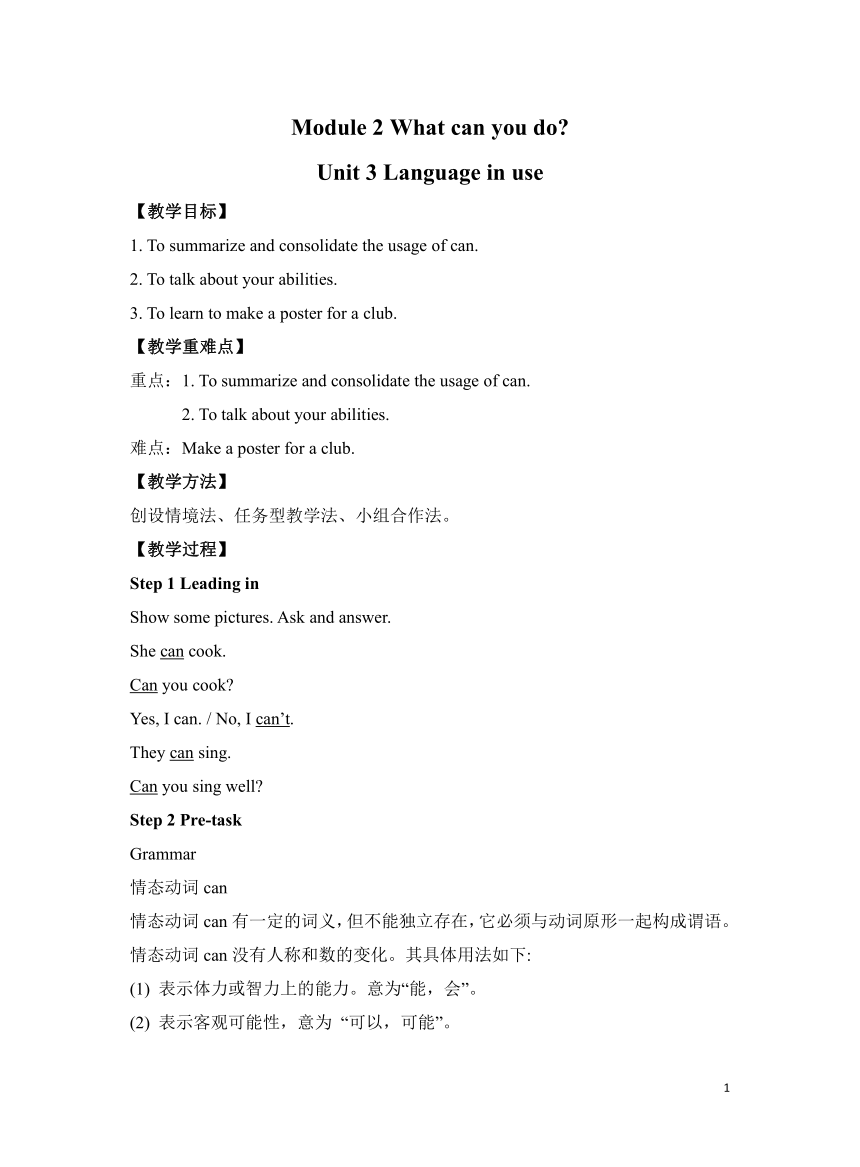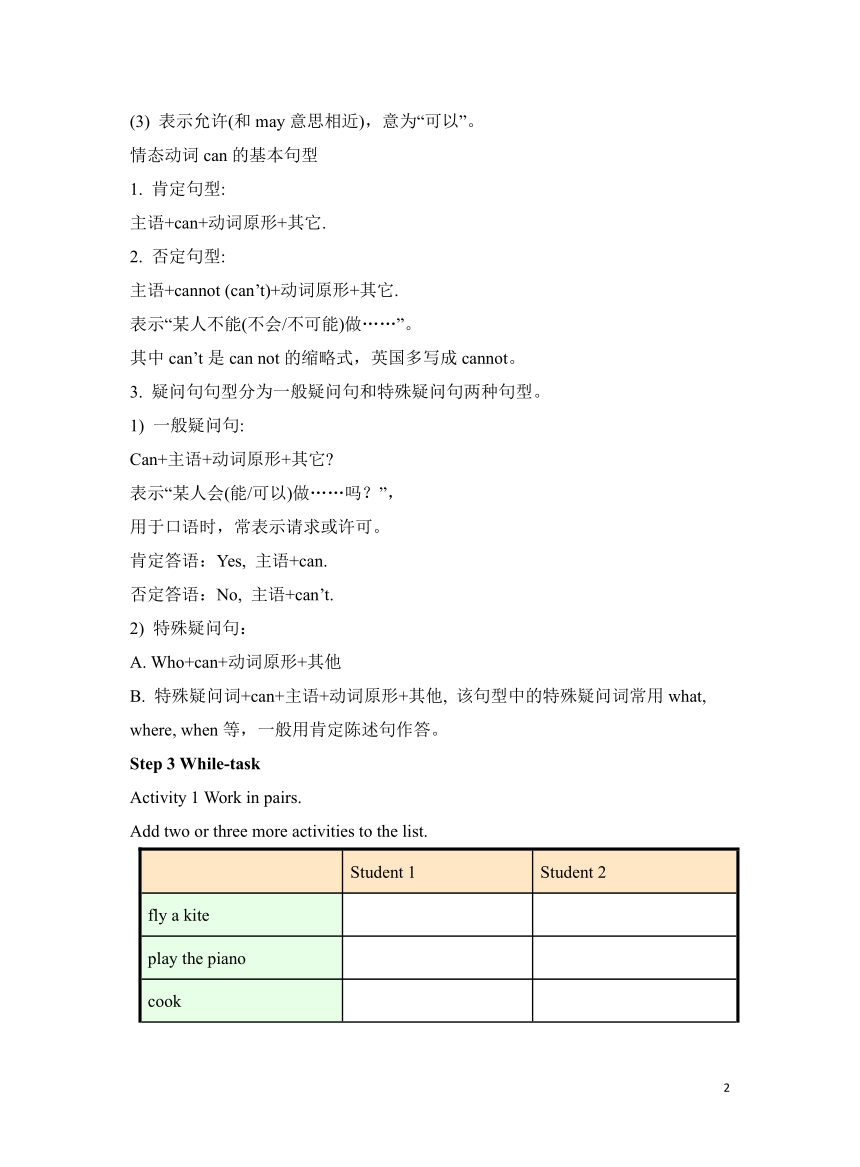初中英语外研版七下Module 2 What can you do ? Unit3教案
文档属性
| 名称 | 初中英语外研版七下Module 2 What can you do ? Unit3教案 |  | |
| 格式 | doc | ||
| 文件大小 | 41.5KB | ||
| 资源类型 | 教案 | ||
| 版本资源 | 外研版 | ||
| 科目 | 英语 | ||
| 更新时间 | 2023-08-30 17:44:05 | ||
图片预览


文档简介
Module 2 What can you do
Unit 3 Language in use
【教学目标】
1. To summarize and consolidate the usage of can.
2. To talk about your abilities.
3. To learn to make a poster for a club.
【教学重难点】
重点:1. To summarize and consolidate the usage of can.
2. To talk about your abilities.
难点:Make a poster for a club.
【教学方法】
创设情境法、任务型教学法、小组合作法。
【教学过程】
Step 1 Leading in
Show some pictures. Ask and answer.
She can cook.
Can you cook
Yes, I can. / No, I can’t.
They can sing.
Can you sing well
Step 2 Pre-task
Grammar
情态动词can
情态动词can有一定的词义,但不能独立存在,它必须与动词原形一起构成谓语。情态动词can没有人称和数的变化。其具体用法如下:
(1) 表示体力或智力上的能力。意为“能,会”。
(2) 表示客观可能性,意为 “可以,可能”。
(3) 表示允许(和may意思相近),意为“可以”。
情态动词can的基本句型
1. 肯定句型:
主语+can+动词原形+其它.
2. 否定句型:
主语+cannot (can’t)+动词原形+其它.
表示“某人不能(不会/不可能)做……”。
其中can’t是can not的缩略式,英国多写成cannot。
3. 疑问句句型分为一般疑问句和特殊疑问句两种句型。
1) 一般疑问句:
Can+主语+动词原形+其它
表示“某人会(能/可以)做……吗?”,
用于口语时,常表示请求或许可。
肯定答语:Yes, 主语+can.
否定答语:No, 主语+can’t.
2) 特殊疑问句:
A. Who+can+动词原形+其他
B. 特殊疑问词+can+主语+动词原形+其他, 该句型中的特殊疑问词常用what, where, when等,一般用肯定陈述句作答。
Step 3 While-task
Activity 1 Work in pairs.
Add two or three more activities to the list.
Student 1 Student 2
fly a kite
play the piano
cook
play table tennis
ride a bike
…
Now write questions for each activity.
Can you fly a kite
Activity 2 Work with another pair. Ask and answer the questions you wrote in Activity 1.
— Can you fly a kite
— Yes, I can. / No, I can’t.
Possible answers:
In our group, four students can fly a kite, everyone can climb trees, three students can’t ride a bicycle and two students can play erhu.
Activity 3 Complete the sentences with can or can’t.
1 —____ you swim
— Yes, but I _____ swim well.
2 —Are you coming with us
—Sorry, I _____ ride a bike.
3 —What ____ the new cleaning monitor do for us
—He ____ make our classroom tidy.
4 —____ you play the piano for us
—Sorry, I _____ play the piano, but I ____ sing for you.
Activity 4 Complete the passage with the words from the box.
beautiful Chinese monitor piano tidy
I like playing the (1)________. I am Chinese so I can speak (2)________ very well and I can speak English too. I am very (3)_______ and I help my mum to clean our home. I want to be the cleaning (4)________ at school because I want to make our classroom (5)_________.
Step 4 Post-task
Activity 1 Around the world
Read and answer.
1. How many languages in the world
2. How many official languages are there
3. What are they
Activity 2 Make a poster.
Draw a picture for your club.
Add the title of your club. Then show your poster to the whole class and talk about it.
Activity 3 Exercise.
一、单项选择。
( )1.Can you play drums (鼓)
A. a B. an C. the D. /
( )2. Can she basketball
A. plays B. play
C. playing D. play the
( )3. _____ club do you want to join
A. How B. When C. Where D. What
( )4. I can’t sing, _____ I can play the guitar.
A. and B. but C. or D. so
( )5. Tom can play the guitar but he _____ play it very well.
A. can B. can’t C. not D. don’t
二、连词成句。
1. play, brother, the, your, guitar, can
2. fly, I, kite, can, a, not.
3. guitar, sing, the, I, play, can, and.
4. to, club, music, join, want, do, you, our
Step 5 Summary
can的自述
我的本领
(1) 表示能力,通常指在体力或脑力方面的能力,意为“能,会”。
(2) 表示许可,意为“可以”。
我的特点
(1) 与动词原形“形影不离”。在句中,can不能单独使用,必须接动词原形。
(2) 没有人称和数的变化。无论主语是第几人称,can不发生任何变化。
Step 6 Homework
1. Make a poster. Draw a picture for your club.
2. Show and talk about your poster with your classmate.
【板书设计】
情态动词can
情态动词can有一定的词义,但不能独立存在,它必须与动词原形一起构成谓语。情态动词can没有人称和数的变化。其具体用法如下:
(1) 表示体力或智力上的能力。意为“能, 会”。
(2) 表示客观可能性,意为 “可以,可能”。
(3) 表示允许(和may意思相近),意为“可以”。
情态动词can的基本句型
1. 肯定句型:
主语+can+动词原形+其它.
2. 否定句型:
主语+cannot (can’t)+动词原形+其它.
3. 疑问句句型分为一般疑问句和特殊疑问句两种句型。
1) 一般疑问句:
2) 特殊疑问句:
1
Unit 3 Language in use
【教学目标】
1. To summarize and consolidate the usage of can.
2. To talk about your abilities.
3. To learn to make a poster for a club.
【教学重难点】
重点:1. To summarize and consolidate the usage of can.
2. To talk about your abilities.
难点:Make a poster for a club.
【教学方法】
创设情境法、任务型教学法、小组合作法。
【教学过程】
Step 1 Leading in
Show some pictures. Ask and answer.
She can cook.
Can you cook
Yes, I can. / No, I can’t.
They can sing.
Can you sing well
Step 2 Pre-task
Grammar
情态动词can
情态动词can有一定的词义,但不能独立存在,它必须与动词原形一起构成谓语。情态动词can没有人称和数的变化。其具体用法如下:
(1) 表示体力或智力上的能力。意为“能,会”。
(2) 表示客观可能性,意为 “可以,可能”。
(3) 表示允许(和may意思相近),意为“可以”。
情态动词can的基本句型
1. 肯定句型:
主语+can+动词原形+其它.
2. 否定句型:
主语+cannot (can’t)+动词原形+其它.
表示“某人不能(不会/不可能)做……”。
其中can’t是can not的缩略式,英国多写成cannot。
3. 疑问句句型分为一般疑问句和特殊疑问句两种句型。
1) 一般疑问句:
Can+主语+动词原形+其它
表示“某人会(能/可以)做……吗?”,
用于口语时,常表示请求或许可。
肯定答语:Yes, 主语+can.
否定答语:No, 主语+can’t.
2) 特殊疑问句:
A. Who+can+动词原形+其他
B. 特殊疑问词+can+主语+动词原形+其他, 该句型中的特殊疑问词常用what, where, when等,一般用肯定陈述句作答。
Step 3 While-task
Activity 1 Work in pairs.
Add two or three more activities to the list.
Student 1 Student 2
fly a kite
play the piano
cook
play table tennis
ride a bike
…
Now write questions for each activity.
Can you fly a kite
Activity 2 Work with another pair. Ask and answer the questions you wrote in Activity 1.
— Can you fly a kite
— Yes, I can. / No, I can’t.
Possible answers:
In our group, four students can fly a kite, everyone can climb trees, three students can’t ride a bicycle and two students can play erhu.
Activity 3 Complete the sentences with can or can’t.
1 —____ you swim
— Yes, but I _____ swim well.
2 —Are you coming with us
—Sorry, I _____ ride a bike.
3 —What ____ the new cleaning monitor do for us
—He ____ make our classroom tidy.
4 —____ you play the piano for us
—Sorry, I _____ play the piano, but I ____ sing for you.
Activity 4 Complete the passage with the words from the box.
beautiful Chinese monitor piano tidy
I like playing the (1)________. I am Chinese so I can speak (2)________ very well and I can speak English too. I am very (3)_______ and I help my mum to clean our home. I want to be the cleaning (4)________ at school because I want to make our classroom (5)_________.
Step 4 Post-task
Activity 1 Around the world
Read and answer.
1. How many languages in the world
2. How many official languages are there
3. What are they
Activity 2 Make a poster.
Draw a picture for your club.
Add the title of your club. Then show your poster to the whole class and talk about it.
Activity 3 Exercise.
一、单项选择。
( )1.Can you play drums (鼓)
A. a B. an C. the D. /
( )2. Can she basketball
A. plays B. play
C. playing D. play the
( )3. _____ club do you want to join
A. How B. When C. Where D. What
( )4. I can’t sing, _____ I can play the guitar.
A. and B. but C. or D. so
( )5. Tom can play the guitar but he _____ play it very well.
A. can B. can’t C. not D. don’t
二、连词成句。
1. play, brother, the, your, guitar, can
2. fly, I, kite, can, a, not.
3. guitar, sing, the, I, play, can, and.
4. to, club, music, join, want, do, you, our
Step 5 Summary
can的自述
我的本领
(1) 表示能力,通常指在体力或脑力方面的能力,意为“能,会”。
(2) 表示许可,意为“可以”。
我的特点
(1) 与动词原形“形影不离”。在句中,can不能单独使用,必须接动词原形。
(2) 没有人称和数的变化。无论主语是第几人称,can不发生任何变化。
Step 6 Homework
1. Make a poster. Draw a picture for your club.
2. Show and talk about your poster with your classmate.
【板书设计】
情态动词can
情态动词can有一定的词义,但不能独立存在,它必须与动词原形一起构成谓语。情态动词can没有人称和数的变化。其具体用法如下:
(1) 表示体力或智力上的能力。意为“能, 会”。
(2) 表示客观可能性,意为 “可以,可能”。
(3) 表示允许(和may意思相近),意为“可以”。
情态动词can的基本句型
1. 肯定句型:
主语+can+动词原形+其它.
2. 否定句型:
主语+cannot (can’t)+动词原形+其它.
3. 疑问句句型分为一般疑问句和特殊疑问句两种句型。
1) 一般疑问句:
2) 特殊疑问句:
1
同课章节目录
- Module 1 Lost and found
- Unit 1 Whose bag is this?
- Unit 2 Are they yours?
- Unit 3 Language in use
- Module 2 What can you do ?
- Unit 1 I can play the piano
- Unit 2 I can run really fast
- Unit 3 Language in use
- Module 3 Making plans
- Unit 1 What are you going to do at the weekends?
- Unit 2 We're going to cheer the players.
- Unit 3 Language in use
- Module 4 Life in the future
- Unit 1 Everyone will study at home
- Unit 2 Every family will have a small plane.
- Unit 3 Language in use
- Module 5 Shopping
- Unit 1 What can I do for you?
- Unit 2 You can buy everything on the Internet
- Unit 3 Language in use
- Module 6 Around town
- Unit 1 Could you tell me how to get to the Nationa
- Unit 2 The London Eye is on your right.
- Unit 3 Language in use
- Revision module A
- Module 7 My past life
- Unit 1 I was born in a small village.
- Unit 2 I was born in Quincy.
- Unit 3 Language in use
- Module 8 Story time
- Unit 1 Once upon a time….
- Unit 2 Goldilocks hurried out of the house.
- Unit 3 Language in use
- Module 9 Life history
- Unit 1 He left school and began work at the age of
- Unit 2 He decided to be an actor.
- Unit 3 Language in use
- Module 10 A holiday journey
- Unit 1 What did you do?
- Unit 2 This morning we took a walk.
- Unit 3 Language in use
- Module 11 Body language
- Unit 1 They touch noses!
- Unit 2 Here are some ways to welcome them.
- Unit 3 Language in use
- Module 12 Western music
- Unit 1 It's so beautiful!
- Unit 2 Vienna is the centre of European classical
- Unit 3 Language in use
- Revision module B
